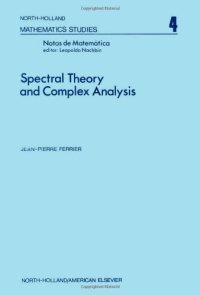
Ebook: Notas de Matemática (49): Spectral Theory and Complex Analysis
- Genre: Mathematics // Analysis
- Series: North-Holland Mathematics Studies 4
- Year: 1973
- Publisher: North Holland
- Language: English
- djvu
The condition of polynomial convexity in the Oka-Weil theorem is the starting point for the author, for the holomorphic functional calculus works when only convexity is assumed for the compact set. He wants to get away from the dependence on Banach algebras by considering approximators that satisfy certain growth conditions. The strategy he uses consists of the spectral theory of (Waelbroeck) b-algebras, which is the topic of this book.
Chapter 1 considers the algebra of 'tempered functions' with respect to a 'weight function', along with the subalgebra of holomorphic functions of this algebra. Examples of this algebra include polynomials, entire functions of exponential type, and holomorphic functions with polynomial growth on an open set. A weight function d on complex n-space is a non-negative function that is O(1/|z|) at infinity and satisfies a Lipschitz condition. The author gives conditions for non-negative functions to be equivalent to weight functions. He also characterizes the algebras of holomorphic functions which are inductive limits of the algebra of tempered functions. For a directed set of weight functions, the author gives examples of these algebras on this directed set.
In chapter 2, the author shows how to cover the tempered and holomorphic algebras with a covering of 'pseudonormed' vector spaces. Such a covering does not give a topology but does allow the desired approximation theory. The algebras then become examples of 'polynormed vector spaces', which are complex vector spaces equipped with a covering of pseudonormed spaces. If each member of the covering is a Banach space then the polynormed space is called complete. The tempered and holomorphic algebras are shown to be complete. Certain special polynormed vector spaces called polynormed algebras are then defined, which are such that the operation of multiplication is a bounded linear mapping. In such structures the product of two bounded sets is bounded, and this called an 'algebra boundedness'. A 'b-algebra' is an algebra with a complete algebra boundedness. The author shows to what degree one can emulate the situation in commutative Banach algebras, namely, remembering that an ideal cannot contain the identity element, the ideal is the whole algebra if the unit is the limit of a sequence of elements in the ideal.
The spectral theory of b-algebras is considered in chapter 3, with the author first reviewing the situation in Banach algebras. The spectra of elements of a b-algebra is not compact, and so the study of the resolvent function cannot necessarily be done on the complement of the spectrum. This motivates the author to define the spectral set of an element of a b-algebra as a condition on the boundedness of the resolvent over the complement of the element. Noting then that the study of entire functions cannot be done using spectral sets, the author defines a 'spectral function' as a refinement of a spectral set, and using this he constructs a holomorphic functional calculus. This involves proving that every spectral function is larger than some spectral function which is a weight function.
After a review of the theory of plurisubharmonic functions, the author considers the spectral theory of O(d), where d is a weight function in chapter 4. The set G on which d is nonzero is shown to be a spectral set if and only if it is pseudoconvex. The author first considers spectral functions START TRANSACTION WITH CONSISTENT SNAPSHOT; /* 2472 = 91d0ddebffca4175acbc98a3850f51dc